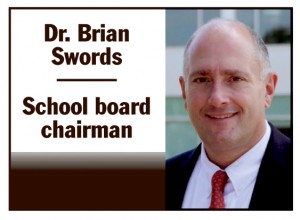School board chairman addresses capital needs
 A great deal of discussion has taken place throughout the School District of Pickens County over the last couple of months related to capital needs funding. When looking at the funding for the school district, one must understand that there’s two “pots” from which funding is pulled. Debt service (capital needs) funding is used to fund buildings, facility improvements, facility upkeep, and other needs such as technology that is used in our schools. Operational funding is what is used to pay our teachers and staff, as well as pay for school operations (utilities) and supplies.
A great deal of discussion has taken place throughout the School District of Pickens County over the last couple of months related to capital needs funding. When looking at the funding for the school district, one must understand that there’s two “pots” from which funding is pulled. Debt service (capital needs) funding is used to fund buildings, facility improvements, facility upkeep, and other needs such as technology that is used in our schools. Operational funding is what is used to pay our teachers and staff, as well as pay for school operations (utilities) and supplies.
The recent discussion that has ensued is related to capital needs funding. Earlier this year, after former superintendent Dr. Kelly Pew warned the school board that she was going to be forced to ultimately close one of the Easley-area elementary schools if a roof wasn’t installed, the board responded with a $13-million spending plan. This plan included roofs for multiple buildings that were in dire need of replacement and HVAC systems that had been ignored in our existing facilities during the district’s building program. The funding for this spending plan was taken from interest that was earned from the building program bonds, as well as more than $3 million that was taken from our operational account (funds that are used to pay our teachers and staff). As a result of this, our school board decided to do a capital needs plan that would be reviewed annually. This plan was developed and approved by the school board in late summer of this year. At that point the debate turned to how to fund the plan.
The passage of the capital needs plan was a positive step forward by our school board. It allowed for the board to predict long-term maintenance and technology needs, instead of scrambling to take care of needs in “crisis mode” as had been done in the past. It was the first step in our school board looking forward, similar to the way a homeowner would do when they knew they had an upcoming major expense, such as a roof. By anticipating your expenses, you have time to plan and budget. Unfortunately, a plan without a mechanism for funding is nothing more than a dream.
After reviewing the capital needs plan, our new superintendent, Dr. Danny Merck, began to sound the alarm that our district was about to enter the “perfect storm.” We were headed into a situation where our capital needs and state-mandated technology enhancements were going to cost almost $6 million next year, and there was no way to fund it. Our only hope was to refinance the building program and take advantage of the lower interest rates. At that time, we expected the refinance would save us around $1.2 million per year. Those savings could then be applied to our capital needs. That would have left us with a $4.8-million shortfall. There were several proposals that could have offset the shortfall: a tax increase, attrition of faculty and staff (cutting jobs of those who leave or retire from the district), and the possibility of closing some of our smaller schools.
I applaud Dr. Merck for sounding this warning and communicating this to the district. Some have said Dr. Merck was using “scare tactics,” but I adamantly disagree with that assertion. I appreciate the leadership he showed in communicating this issue honestly throughout our county. He even went a step further and involved community stakeholders in an exercise to identify a possible funding plan.
In early November, the school board learned that if they took advantage of historically low interest rates and refinanced the bonds early from the building program, they would gain $3.2 million in savings, instead of the $1.2 that was originally projected. Dr. Merck then presented the board with three options: 1. No tax increase, which would take advantage of the refinancing of the building program and net $3.2 million each year for capital needs; 2. a 5-mill tax increase that would generate approximately $5.8 million each year; or 3. a 10-mill tax increase, which would generate $8.5 million per year. Dr. Merck’s recommendation was for the 5-mill tax increase. The 5-mill increase would add approximately $20 per year to the tax bill of the owner of a $100,000 home. The $5.8 million per year generated from the 5-mill increase would take care of the districts capital needs going forward each year.
While I strongly support Dr. Merck’s recommendation of the 5-mill increase, there were not enough votes from our board to approve it on second reading. The board was split 3-3, and as such, the measure would have died had the board not approved the no tax increase option that netted $3.2 million in savings from the bond refinance.
The measure requires a third reading, which was to take place on Monday, Dec. 15. Leading up to the Dec. 15 meeting, we learned from the school district’s financial advisor that the bonds would not be refinanced until late spring, and we had a few more months to consider and debate the plan. In addition, several members of our board indicated they felt rushed into making a decision if the third reading was to take place on Dec. 15. Others even said they would like time to go through the capital needs list to determine the level of need for each expenditure. Another request was to try to identify wasteful spending within the schools that could be salvaged, which could possibly free up funds.
Realizing that the bond refinance would not take place until late spring, and understanding the questions that several our board members were struggling with, I recommended to the board that we push the third reading out until spring in order to give time for the capital needs plan to be forwarded to the board’s facilities committee, and for a plan to be put in place to identify any wasteful spending. In addition, an ad-hoc committee, comprised of several board members and key members of the district’s leadership team, are working on a strategic plan for the entire district. This strategic plan is slated to be finalized by mid-spring, and may also play a role in determining the capital needs of the district. In essence, delaying the third reading allows us to keep from putting the “cart before the horse.”
Dr. Merck has taken an active role in communicating this to the entire district in an honest and factual manner. Some have criticized him for even bringing up the idea of school consolidation; however, when you look at the situation from a business perspective, one must consider the idea of consolidation if other funding is not identified. No school will consolidate or close during the 2015-16 school year. I agree that our smaller schools are points of pride in our school district, but we must realize that they also cost us almost double per-pupil to operate when you factor in the cost of upkeep, utilities, and staff when compared with our larger schools of standard size. It is my hope that we do not need to resort to consolidating any school in the future and this issue can be resolved simply by finding the funding needed to fund our capital needs.
In closing, I appreciate the work of our school board, Dr. Merck, our district leadership, our teachers and staff. Throughout this process, I have heard from citizens on both sides of this issue. Many continue to echo the distrust that resulted from the building program. While that was almost 10 years ago, that distrust continues to resonate throughout Pickens County. It is hard to move past it, as the building program was wrought with its share of mistakes. However, everyone must realize most of the current board members and the vast majority of our school district administrators were not even involved in the building program. We have to start trusting each other and realizing that we are now challenged with protecting the investment of the building program and ensuring the children that are graduating from the state-of-the-art buildings that resulted from the building program are equipped with the best possible education in order for them to be competitive in the workforce.
I ask that the citizens of Pickens County continue to take an active role in this discussion and other ongoing issues impacting our schools, not only now, but in the future.
Dr. Brian D. Swords is chairman of the Pickens County School Board of Trustees.




























